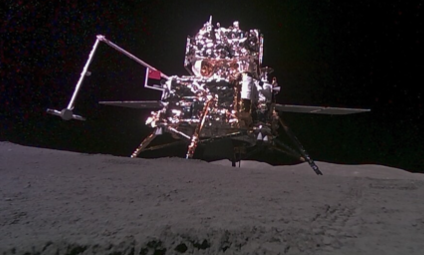On June 2, 2024, at 7:38 a.m. Beijing time, China’s Chang’e-6 lunar probe touched down on the moon’s surface after several weeks of traveling. For the first time, it placed the Chinese flag on the far side of the moon, drilled and collected nearly 2,000 grams of rock and soil samples, and departed with them on Tuesday, June 4.
The automated probe is expected to make its return to Earth on June 25. If it lands, it will mark the first time that lunar samples will be obtained from the far side of the moon.
“This is a historic step in China’s space exploration and, more importantly, a step of the peaceful use of space in human history,” said Foreign Ministry spokesperson Mao Ning on the accomplishment of Chang’e-6.
According to the China National Space Administration, the probe “withstood the high temperatures of the lunar far side,” ranging from 127 degrees Celsius in the day, to negative 183 degrees during the lunar night. Additional challenges arose from the uneven terrain of the far side of the moon, as well as the limited communication which was only possible through satellite, because the probe’s landing site did not face the Earth.
This is not the first time a Chinese mission has brought back lunar samples. In 2020, China’s Chang’e-5 probe brought back samples from the near side of the moon. These samples provided key research on the existence of hydroxyl molecules on the moon, confirming the existence of water molecules on the lunar near side. Because of the lack of prior samples from the far side of the moon, Chang’e-6 is expected to provide much more information on this largely unexplored area of space.
“We can conduct exploration and research on the oldest soil and lunar soil on the moon, which will reveal the history of the formation of the moon,” said chief scientist Wang Chi of the Chang’e missions, according to China Central Television. “Our panoramic camera will be used to detect the terrain and landforms, and an important payload is the lunar radar, which will be used to investigate the geological structure.”
This mission brings about new concerns for some scientists. After the United States landed on the moon for the first time in 50 years with Odysseus in February of this year, and India launched its Chandrayaan-3 lunar lander in March, NASA chief Bill Nelson has issued his concern that a second global “space race” is developing, as China is expected to hold onto Chang’e-6’s samples until 2026.
“I don’t want them to get [to the Moon] and say, this is ours,” said Nelson, according to NPR. “It ought to be for the international community, for scientific research. So that’s why I think it’s important for [the United States] to get there first.”
With the success of its probe, China plans to follow this mission with two more Chang’e probes, with the ultimate goal of landing an astronaut on the moon by 2030. The United States has also announced plans for a lunar astronaut mission in 2026, although there is not as clear of a timeline for this voyage.
Chang’e-6 may have added some polarization in the scientific community, considering its close ties to China’s rapid expansion in space exploration. Whether its mission remains a national or a global effort, it is bound to provide scientists and the public alike with crucial information on the relatively unknown dark side of the moon.


